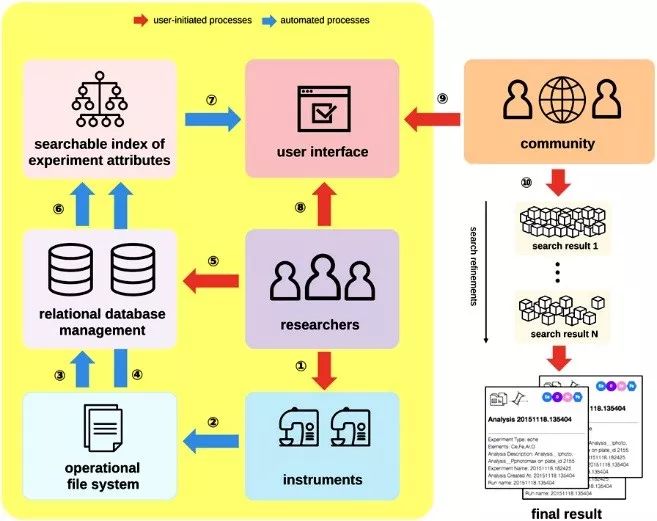科技工作者之家
科技工作者之家APP是专注科技人才,知识分享与人才交流的服务平台。
科技工作者之家 2019-08-23
来源:知社学术圈
材料在许多技术中起着关键作用。现代数据科学的应用,可加速新材料发现和优化的机会,促进材料信息的生成、存储和检索方式的转变。之前,检索大多数“简单”材料(元素和一些二元相)的基本属性的唯一方法,是在材料数据库中手动查找。
但这些数据库散杂着各种材料的稀疏信息,需要高水平的验证,且没有记录材料发现研究的前沿问题。高通量计算和实验的出现加速了对合成空间的探索,特别是那些含有多种元素的材料的合成空间。探索如此庞大、高维度构图空间,迫使人们建立了用来组织和传播材料数据的新数据管理协议。
计算材料数据库(如,材料项目、OQMD和AFLOW等)努力开创了虚拟材料、新近发布的高通量实验材料,而目前开创的数据管理和材料实验传播等方面的重大进展,则强调了元数据的管理在实验材料科学中的重要性和挑战。
来自美国加州理工学院人工光合作用联合中心的John M. Gregoire教授,开发了一种轻量级数据管理框架来解决管理和链接全然不同的合成和表征的实验数据所带来的挑战,并成功建立了材料实验和分析数据库(MEAD),其中包含了来自数百万种材料的合成实验和表征实验的原始数据和元数据,以及由附带的开源存储库中的软件进行数据分析和升华得到的属性数据和性能指标数据。MEAD为研究人员提供了数百万种材料的合成和材料表征信息,主要是光学和电化学特性信息。通过追踪数据处理中使用的算法,MEAD提供了完整的数据衍变谱系,因此用户可以探索原始数据及其派生属性的解释。Web搜索界面可使用嵌入式DOI检索数据,并下载所需的原始和/或分析数据集。数据和元数据管理旨在吸引快速发展的数据科学领域,为材料实验提供附加值,并促进材料科学中计算机辅助发现新材料的应用。
该文近期发表于npj Computational Materials 5: 79 (2019),英文标题与摘要如下,点击左下角“阅读原文”可以自由获取论文PDF。

Tracking materials science data lineage to manage millions of materials experiments and analyses
Edwin Soedarmadji, Helge S. Stein, Santosh K. Suram, Dan Guevarra & John M. Gregoire
In an era of rapid advancement of algorithms that extract knowledge from data, data and metadata management are increasingly critical to research success. In materials science, there are few examples of experimental databases that contain many different types of information, and compared with other disciplines, the database sizes are relatively small. Underlying these issues are the challenges in managing and linking data across disparate synthesis and characterization experiments, which we address with the development of a lightweight data management framework that is generally applicable for experimental science and beyond. Five years of managing experiments with this system has yielded the Materials Experiment and Analysis Database (MEAD) that contains raw data and metadata from millions of materials synthesis and characterization experiments, as well as the analysis and distillation of that data into property and performance metrics via software in an accompanying open source repository. The unprecedented quantity and diversity of experimental data are searchable by experiment and analysis attributes generated by both researchers and data processing software. The search web interface allows users to visualize their search results and download zipped packages of data with full annotations of their lineage. The enormity of the data provides substantial challenges and opportunities for incorporating data science in the physical sciences, and MEAD’s data and algorithm management framework will foster increased incorporation of automation and autonomous discovery in materials and chemistry research.

来源:zhishexueshuquan 知社学术圈
原文链接:http://mp.weixin.qq.com/s?__biz=MzIwMjk1OTc2MA==&mid=2247498928&idx=2&sn=433ab2cb71314ed9617d252129f5ae6f&chksm=96d4024fa1a38b599b41dcbf30e619326eeafa6ea2dea06bdbedc26e3195e6193dee40d38e5c&scene=27#wechat_redirect
版权声明:除非特别注明,本站所载内容来源于互联网、微信公众号等公开渠道,不代表本站观点,仅供参考、交流、公益传播之目的。转载的稿件版权归原作者或机构所有,如有侵权,请联系删除。
电话:(010)86409582
邮箱:kejie@scimall.org.cn
科学大数据——国家大数据战略的基石
大数据应用及其解决方案(一):大数据概述

郭华东:科学大数据是国家大数据战略的基石
构建云生态,深化云应用 第九届中国云计算大会闭幕
2015年新疆云计算大数据技术应用研讨会召开



【预告】IGAL14 | Data-driven Sketch Interpretation
大数据时代工业数据发展

用大数据审判大数据
第九届中国云计算大会·科猫邀你免费入场

大数据助力疫情防控|疫情排查,大数据大展身手